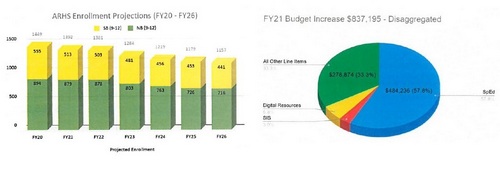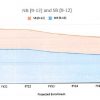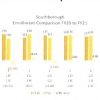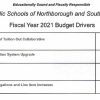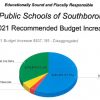Above: Presentations on recommended FY21 budgets highlighted enrollment figures and drivers behind increased costs. (images cropped from regional and K-8 presentations)
Tomorrow night, the Regional School Committee will hold a meeting in Algonquin’s library at 7:00 pm. First on the agenda for March 18th is a public hearing on the recommended budget for FY21. The intent is to broadcast the meeting live via Northborough Cable Access.*
The upcoming meeting prompted me to dive into the recommended budget and the K-8 version.
Looking at the combined impact on Southborough taxpayers for the K-12 district public schools budgets, it appears to be a $678,523 increase over last year. (That’s presuming the budgets get passed at Town Meetings.) The increase is based on a 4.02% increase to the K-8 budget and a 2.08% reduction to Southborough’s assessment for regional grades 9-12 (Algonquin and our share of the district overhead.)
The Regional budget to be presented tomorrow calls for a total 3.31% increase over the FY20 budget, or $24,562,373. After state aid and money from the Excess & Deficiency fund** are deducted, the amount assessed to Southborough taxpayers will be a $158,672 reduction from last year. Northborough’s assessed payment will increase by 4.36%.
Meanwhile, student enrollment at Algonquin is projected to decrease next year. The presentation from the February meeting shows an expected 3.93% decline, with a 7.56% reduction in Southborough students. (See chart and graph below.)
In Southborough K-8 schools, student enrollment is projected to increase just 1.32%. Some grades went up while others went down. (See chart above.)
The drivers named as largely responsible for this year’s budget increases included contractual obligations and line item increases, costs related to special education (9-12 Tuition Collaborative and K-8 out of district placements), Student Information System upgrades, and K-8 Digital Curriculum, (See tables below below for figures and the K-8 graph for perspective.)
Member Paul Butka from Southborough serves on Regional’s budget subcommittee. In February, he told fellow Regional committee members that it’s been a tough year:
The new contract came in and we’ve got some contractual obligations as a result of that. At the same time, student population’s actually decreased and we wanted to be cognizant of that.
He said the excess they had in the E&D fund** allowed them to contribute $300,000 to keep the Towns’ assessments down. They will still maintain at least 3%, in keeping with the district’s policy, in the “rainy day” fund. Butka explained that thanks to the Governor’s package and excellent management of the school they ended up with more in the E&D than expected, more than they could keep. He opined that in future years they would need to assess if extra money in the fund should be put towards the OPEB trust.
Superintendent Greg Martineau said the decision to put the money towards lowering assessment cost followed discussions with Town managers. He advised that it was important to help keep the Town’s operating budgets under levy to avoid requiring voters to pass an override. He was also keeping the “educational landscape” of K-12 in mind, not just grades 9-12.
Helping to offset the costs for taxpayers this year, the budget subcommittee supported contributing $300,000 from the Excess & Deficiency fund.
Click here for the detailed Regional recommended budget presentation from the committee’s February meeting when they voted to support it.
The K-8 Southborough School Committee already held its hearing in February. You can see the video here courtesy of Southborough Access Media. Click here for the detailed recommended budget presentation from that committee’s January meeting when they voted to support it.
*Northborough Cable Access Television’s live broadcast is available in Southborough on Verizon-29 and Charter-194 or via live stream. The meeting will also be rebroadcast through NCAT’s YouTube channel and VOD player.
**I wasn’t familiar with E&D, so I pulled up this requirement by Mass DOE explaining the fund. It is apparently intended to hold unforseen revenue/savings to cover future years’ unforseen costs:
(1) Every regional school district shall maintain an excess and deficiency fund on its books of account. At the end of every fiscal year, any surplus or deficit in the district’s general fund shall be closed to the excess and deficiency fund.
(2) On or before October 31 of each year, every regional school district shall submit to the Department of Revenue the forms and schedules as the Department of Revenue requires for the purpose of reviewing and certifying the balance in the regional school district’s excess and deficiency fund. At the discretion of the Commissioner, the Department may withhold release of all or some part of the quarterly state school aid for the regional school district if the regional school district has not filed the required forms and schedules by such date.
(3) A regional school committee may use all or part of the certified balance in the excess and deficiency fund as a revenue source for its proposed budget. If the certified balance exceeds five percent of the proposed budget, the regional school committee shall use the amount in excess of five percent as a revenue source for its proposed budget.

